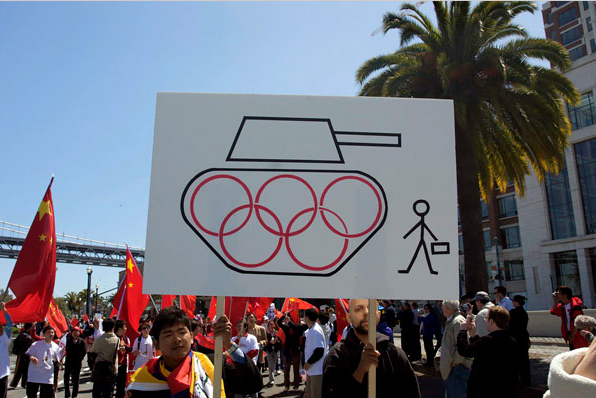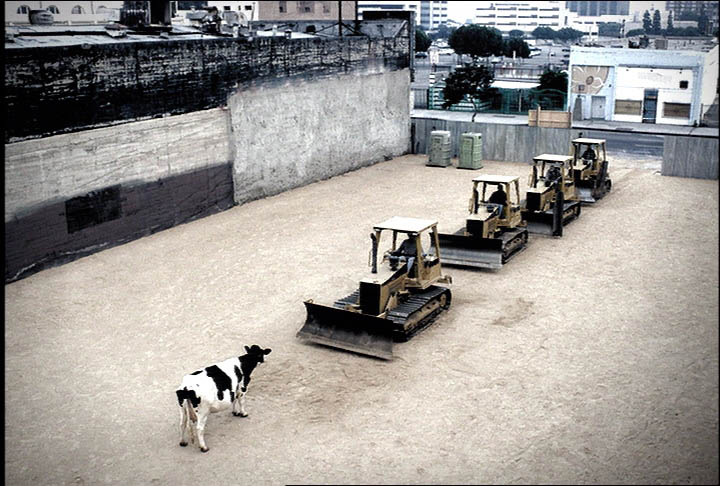From time to time we comment on creative appropriations of iconic photographs. One image that has been frequently copied, parodied, and otherwise appropriated to various political and commercial ends is the photograph of the lone individual standing before a row of oncoming tanks in Tiananamen Square in 1989. The image has shown up with some frequency recently in protests against the upcoming Beijing Summer Olympics, as in this photograph of a rally in San Francisco that appeared this past week in the NYT. The iconic photograph (which is really three different photographs by three different photojournalists—Jeffrey Widener, Charles Cole, and Stuart Franklin—all shot from similar but nevertheless different vantages) is widely recognized throughout the western world, but interestingly, it has almost no visibility or recognition in China where it has been effectively censored.
We have written about the image somewhat extensively in No Caption Needed (the book) where we argue that the image activates a cultural modernism that displaces democratic forms of political display and opposition (remember that the protests in Tiananmen Square included thousands of students and nearly a million protesters in all who had organized in various groups) and plays to western conceptions of individualism and apolitical social organization. Thus, while the original photograph can function as a progressive celebration of human rights, it also risks limiting the political imagination to narrowly liberal versions of a global society.
We see the possible implications worked out to some extent in an ad for Chick-fil-A that parodied the Tiananmen Square photograph during the 2002 Peach Bowl. To see the ad click on the image below.
As we note in our discussion of the image in No Caption Needed, the ad’s sophistication speaks volumes about liberal-democratic identity construction. Key features of public dissent are recreated within a comic fame that allows one to enjoy them without actually becoming in any way committed to political action. Instead, identification occurs entirely with regard to a topography of private life: the viewer makes choices about small scale consumer consumption—where to drive through tonight?—that supposedly are choices between social conformity or individual self-expression. Cows cannot speak and consumers are not likely to speak out, but the comic imitation of a silent act of public protest makes consumption appear to be a public act. The democratic mythos of representing the will of the people to challenge authoritarian power becomes a vehicle for motivating completely individuated acts within private life. But the active agent with whom we are invited to identify is a cow with no voice. And there, of course, is the rub, for while the ad is witty, it nevertheless also masks a deep fatalism about individual powerlessness as it asks us to smile along when the brutal suppression of a popular movement is remembered as an argument to shift our allegiance from one fast food franchise to another.
Photo Credits: Reagan Louie/NYT; Chick-fil-A, Inc./The Richards Group. For our detailed discussion of the Tiananmen Square photograph and its many appropriations, see No Caption Needed, 208-41.


[…] its various iterations and appropations see our chapter in No Caption Needed (the book) and posts here and here.) Share and Enjoy: These icons link to social bookmarking sites where readers can share […]
[…] No Caption Needed :: A Man, A Tank, and A Cow Posted by .米迦. Filed in 網擇, Other's works Leave a Comment » LikeBe the […]